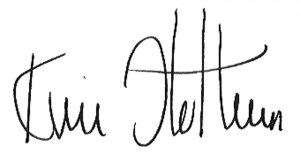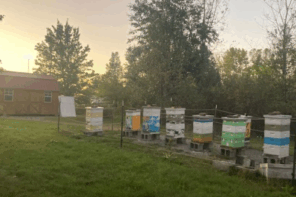By : Kim Flottum
Webinars aren’t new. But if you haven’t, take a look at the webinars we do here and let me tell you just a little about them. It’s called the KIM&JIM show.
Jim Tew and I irregularly schedule (about one a month) a meeting with people or places, live and together, or on separate cameras maybe with a guest. Sometimes it’s with somebody doing a talk with a powerpoint, and it’s a lot like sitting in the audience at a meeting, but you didn’t have to drive there, dress up, or pay. You can listen live on your computer, usually at the same time every time we do them, or call one up in the evening, with your slippers on and a beer, on the couch.
When we have a guest, all three, or more, of us share a small part of the screen and the slide from the powerpoint hogs the middle. All of us have audio so we can break in with a question, or to have some point clarified any time we want. It’s recorded, but not edited, and you can find them all, there’s about 20 or them, on a link on Bee Culture’s web page.
Because they aren’t edited, anything, and everything that happens goes on the recording. We’ve had some interesting events happen when live – phones ringing, my computer crashed completely once, and it took about 30 minutes to get it back, friends calling in during the show, sneezes, switches not working. Live is an adventure, every time. But here’s the best part. If you are watching live, you can actually ask a question of the folks doing the program. There’s a place to type in a question on your screen when you register, and when the presenter is finished, we’ll answer those questions, live, on the air. “Mike, in Tulsa, wants to know why you didn’t just . . .” and you’ll find out.
Most memorable probably was the time we were going to look at Jim’s beeyard, just for kicks, for an hour or so. We pulled into the driveway and right next to his fenced in yard was his pickup, with a step ladder in the back. And a swarm hanging in a tree about six feet above the ladder.
You’ll have to watch the show to see what happens next, but I’ll bet you’ve been there – pickup, ladder, swarm, and an adventure waiting to happen.
Now that technology lets us get outside, we’ll be doing a lot of beeyard adventures this summer, in our yards or, well, who knows.
We’ve done shows with Dewey Caron, Val Dolcini, the President and CEO of the Pollinator Partnership, members of the Project Apis m BOD, The Honey Bee Health Coalition, a program from New Zealand, and the whole crew at the BIP lab.
Coming up this spring we’ll be with the National Honey Board people showing their most recent promotional material, we’ll spend a day with a bunch of State Apiary Inspectors talking about what’s going on in their states and the industry. I think we’ll have MA, FL, TX, ND, TN, ME and maybe more. That should be interesting.
Steve Pernal, a research scientist from the BeaverLodge Research Farm in Alberta, Canada, we hope, will be doing a couple of programs with us. One on the nationwide breeding program they have going on in Canada (it is VERY impressive), and another on basic disease issues, including AFB, EFB and viruses. You really don’t want to miss these.
And Andony Melathopoulos, who has kind of a dual role at Oregon State. He works with Pollinator Health Extension in the Department of Horticulture there. And, since honey bees are pollinators, he’s involved with that side of the business. He has a program working with the public on pollinator gardens that’s incredible, and should be a good model if you are thinking of starting something like this.
And because he’s a beekeeper, he’ll be here talking about making and using nucs. Something we can all use more of.
Podcasts aren’t new either, so let me share a bit about the one we do here. It’s called the BeekeepingTodayPodcast. This is with Jeff Ott, a long-time hobby beekeeper who used to live here in Medina, and now in Olympia, WA. He’s the tech wizard for these, making the software, hardware and editing work.
We do these about once a week and have 20 posted on the web page and available on most of the podcast platforms out there.
In early February we finished with Reed Johnson about spraying pesticides on almonds, Tom Seeley on his new book about the lives of wild bees, and Brad Root on a bit of A. I. Root Company history because of our 150th anniversary this year. And by the time you get this there will probably be more.
But already there’s Sam Ramsey and fat bodies, Marina Marchese and honey tasting, Dan Conlon on Russian Bees, Tom Theobold on the neonics, James Wilkes on Hive- Tracks and more. Due up next is Eric Wenger, who runs True Source Honey and Samantha Brunner, the State Apiary Inspector for North Dakota, certainly the busiest inspector we could find, and she’s also the President of the Apiary Inspectors of America, so that should be an interesting program.
The best thing about these is that you can listen anytime you want – half on the way to work, half coming home, on the way to the beeyard or in the workshop. And you can use your computer, or mobile device, and, they are free.
Yes, this has been kind of a commercial, but I hope you get a chance to listen to some of the most important voices in beekeeping today. Your bees will be glad you did.
This is the 397th time I’ve written an Inner Cover column. Why Inner Cover you ask? Well, when I started I kind of felt the person who sat in this chair was between the bees, and the rest of the world. The cover keeps everything outside, outside. But there’s room to move just below, but not a lot, to get to the bees. Kind of a filter. Kind of a buffer.
I’ve tried to keep that going all these years, mostly, but not always succeeding. Let the good stuff in, keep the bad stuff out. Let the bad stuff out, keep the good stuff in. It works for me.
This being our 150th year, it begins my 34th year here, just over 22% of the total time the company has been in business. Time flys.
You Never Know.
Back about 1994 or so, a backyard hobby beekeeper somewhere in the Midwest had lost his bees, again, and was about fed up with this new hobby. He told his wife he was about done with this foolishness and was going to hang it up.
Then he saw a promotional video for an EAS meeting to be held in Wooster, Ohio, the next Summer. He liked what he saw, and thought that if this meeting couldn’t help him, nothing could, and that’d be the end of it.
Well, he came for the week-long meeting, spent nights in an unairconditioned dorm during the hottest two weeks NE Ohio had suffered through in decades, but had more fun, learned more beekeeping and met more good people than he thought imaginable. He went home enthused, excited, engaged and ready to go.
He’s still keeping bees today, and I ran into him recently and he related that story. In the interim, however, his professional skills and willingness to raise his hand have put him in positions of leadership of big, and bigger beekeeping groups, on the boards of several national research and grant offering organizations, and as support for large, regional groups and their meetings. His skills, his energy and his enthusiasm have propelled beekeeping in his part of the world giant steps and accomplished much that needed doing. He has done well, and we are much better because he’s still here. Thanks Bob. EAS ’95, The Year Of The Hive. You just never know.
One more thing. Recently we’ve started two new features each month. BEETALK is where you send in questions to have our regulars, and guests, answer. Any kind of question (seasonal preferred, but not required) and we’ll use those that work the best. Each may get answered by everybody, nobody, some of each. We don’t require the folks who are answering to answer every question. Some don’t have that kind of experience or skill. But, we’ll get as many as we can. Send in your questions.
And then, we have our Honey Reporters tell us what are the two or three most important things to do in their region NEXT month, so you can be prepared for next month, ahead of time. This month is too late, so get what your need for your bees, in your region in NEXT MONTH, a part of the Monthly Honey Report.
Ok, one more. IN THE BEEYARD begins this month. You’ve seen this in other magazines for sure. Send in that idea you had that solved an equipment problem, a harvesting problem, a bottling problem, a better way to do pallets, a better way to move bees in a beeyard, a better way to do anything that will solve a problem, save you time, save you money, help do better, faster, smarter, easier, cheaper. It’s not something you invented and are selling, it more like what’s an easier way to clean propolis from the inside of a super after it was extracted, or, a really good homemade beetle trap, or…well, you get the idea.
Send in your idea, a drawing or photo if you have to show me. If it’s the best one we get that month, you’ll get $100. If it gets picked to put in the article that month you’ll get a free subscription. If we aren’t overwhelmed, we may skip a month so the next time we are, but don’t slow down. Send them in.
IN THE BEEYARD. Send in all those great ideas. Help thousands of beekeepers run a better, faster, easier, smarter operation. And maybe get a little cash for your idea.
Because of the Government shut down in January, our annual honey report, usually out in May, won’t be out until July this year. What a mess. And, as I write this in February, the threat of even more time off for our USDA folks threatens. What a mess.












